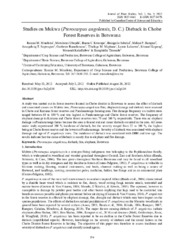| dc.contributor.author | Mmolotsi, Ronnie M. | |
| dc.contributor.author | Obopile, Motshwari | |
| dc.contributor.author | Kwerepe, Baone C | |
| dc.contributor.author | Sebolai, Boingotlo | |
| dc.contributor.author | Rampart, Melusi P. | |
| dc.contributor.author | Segwagwe, Amogelang T. | |
| dc.contributor.author | Ramolemana, Gaebewe | |
| dc.contributor.author | Maphane, Tlholego M. | |
| dc.contributor.author | Lekorwe, Lerato | |
| dc.contributor.author | Kopong, Ishmael | |
| dc.contributor.author | Kelatlhilwe, Moneedi | |
| dc.contributor.author | Tiroesele, Bamphitlhi | |
| dc.date.accessioned | 2022-11-14T08:39:38Z | |
| dc.date.available | 2022-11-14T08:39:38Z | |
| dc.date.issued | 2012-08-20 | |
| dc.identifier.citation | Mmolotsi, R. M., Obopile, M., Kwerepe, B. C., Sebolai, B., Rampart, M. P., Segwagwe, A. T., ... & Tiroesele, B. (2012). Studies on Mukwa (Pterocarpus angolensis, DC) Dieback in Chobe Forest Reserves in Botswana. Journal of Plant Studies, 1(2), 154. | en_US |
| dc.identifier.issn | 1927-0461 | |
| dc.identifier.issn | 1927-047X | |
| dc.identifier.uri | https://ccsenet.org/journal/index.php/jps | |
| dc.identifier.uri | https://hdl.handle.net/13049/581 | |
| dc.description | The article was published under CC BY 3.0 license. | en_US |
| dc.description.abstract | A study was carried out in forest reserves located in Chobe district in Botswana to assess the effect of dieback and associated causes on Mukwa tree, Pterocarpus angolensis Fire, elephant damage and dieback were assessed in Chobe and Kazuma forest reserves and Pandamatenga farming area. Fire damage frequency on mukwa trees ranged between 60 to 100 % and was highest in Pandamatenga and Chobe forest reserves. The frequency of elephant damage in Kazuma and Chobe forest reserves was 75 and 100 % respectively. There was no elephant damage in Pandamatenga farms because the area is fenced out and minor dieback occurred in the area. All areas under study experienced 100 % incidence of dieback, but the severity ranged from 22 to 100 %, the highest being at Chobe forest reserve and the lowest at Pandamatenga. Severity of dieback was associated with elephant damage and age of P. angolensis trees. The incidence of dieback was correlated with DBH and tree age. Theresults indicate that the cause of dieback is mostly due to elephant and fire damage. | en_US |
| dc.language.iso | en | en_US |
| dc.publisher | Canadian Center of Science and Education (CCSE) [Society Publisher] | en_US |
| dc.relation.ispartofseries | Journal of Plant Studies;1(2), 154 | |
| dc.subject | Pterocarpus angolensis | en_US |
| dc.subject | Dieback | en_US |
| dc.subject | Fire | en_US |
| dc.subject | Elephant | en_US |
| dc.subject | Botswana | en_US |
| dc.title | Studies on Mukwa (Pterocarpus angolensis, D. C.) Dieback in Chobe Forest Reserves in Botswana. | en_US |
| dc.type | Article | en_US |

